Gamebox 2.0: Games of April 2024
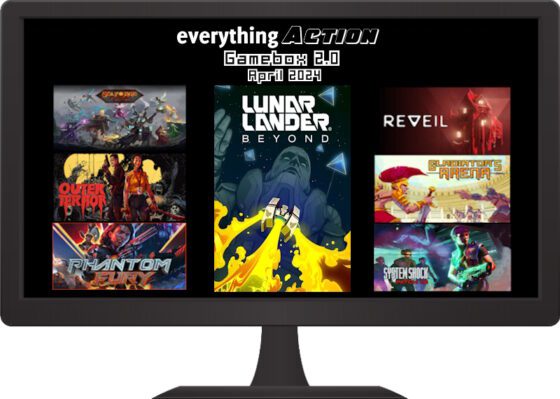
Spring brought us some fresh action titles this month. We dove into some Vampire Survivors-style shooting with Gladiator Arena, delivered some punishment with a bionic hand in Phantom Fury, navigated dangerous terrain in Lunar Lander Beyond, battled on the digital tabletop in Solforge Fusion, and more! Check out everything we played this month below in the Gambox 2.0 of April 2024.
Outer Terror (Zach): Outer Terror is a new rogue-like horde shooter from Ratalaika Games and VoxPop Games that pays homage to classic B horror and sci-fi movies (We received a code via PR Hound on behalf of Ratalaika). It features five different scenarios, such as an apocalyptic war with machines, a creeping Lovecraftian horror, zombies, and more. You can choose from 10 characters with different starting weapons and special abilities. As you progress through the stage, you can collect a massive arsenal of weapons that fire automatically, along with unique, one-time-use items that can give you a boost. The maps are enormous, but luckily, you have a mini-map that lets you see where you’ve been before and where you need to go next. There are tons of enemies to take on, and each stage builds to a massive boss battle if you can survive that long. In rogue-like fashion, when you die, you lose all the weapons and items you collected in the previous run, but you do accumulate money that you can use to purchase permanent upgrades to help you last longer.
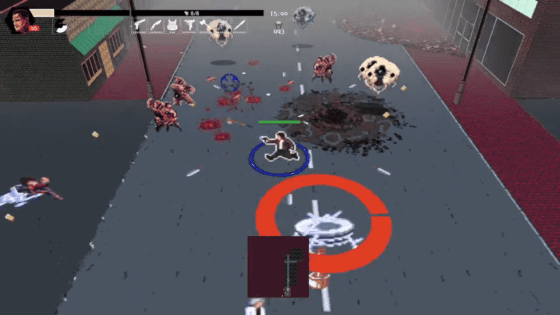
The game features some retro-style graphics that feel like something from the PS1 era, and you’ll probably either find them charmingly retro or extremely ugly, depending on your personal preferences (I lean more toward charmingly retro). The story for each scenario is told in some pretty cool, Creepshow-style comic art from Joe Roman. Each scenario has objectives to try and complete instead of just trying to survive the enemy hordes, which gives it a bit more structure than some of the other similar games in the genre. I would have liked to have seen a bit more guidance from the map, like a beacon or objective markers, so that you have a slightly better sense of where to go. Sometimes, I felt like I had combed the entire map and still hadn’t stumbled onto what I needed to do to progress and face the boss. I also ran into what was hopefully just a weird glitch where all my weapons stopped working except for laying a mine, which made the run pointless. There doesn’t seem to be any concern for ammo, so hopefully, that was just a one-time glitch and not a recurring issue. The B movie horror style and more structured gameplay make Outer Terror something to check out for fans of games like Vampire Survivors, and it lets you build up a ridiculous arsenal to battle the enemy hordes. It’s out now on Xbox X|S, PS4/5 and Nintendo Switch.
Phantom Fury (Chris): Shelly “Bombshell” Harrison returns to blow things up and punch things down with a killer right hook in Slipgate Ironworks and 3D Realms’ Phantom Fury. This game is the latest installment of the Bombshell series, that follows Global Defense Force bomb specialist Shelly Harrison stopping world domination plans. Phantom Fury picks up many years after the events of Ion Fury, where Shelly awakes from a coma with a new bionic arm. She is given a mission to retrieve a highly dangerous artifact before it falls into the wrong hands. Shelly will face off against rogue soldiers, mutants, and hulking weapons of war to prevent the destruction of the USA.
Phantom Fury is a retro shooter inspired by the late 90s era of FPS, particularly Half-Life. Early Valve designs heavily influence the gameplay and environments. The classic boomer shoot tone of the Ion Fury is still in the core code of the game, but Phantom Fury features physical-based puzzles, semi-open spaced layouts, and a wider focus on exploration. Shelly will be aided by her superior Colonel Graywater and GDF scientist Dr. Crawford, who will give Shelly some directions on her mission but won’t provide much detail. The greater background plot is told by emails and logs found from computers, and a few NPC conversations you will get by taking the time to look around.
Phantom Fury is built on the Unreal Engine, updating the visuals and the shooting mechanics to a blocky retro 3D. A multitude of weapons return from the previous game but the newest addition to Shelly’s arsenal is her bionic right hand. Shelly can unleash a punch to create openings or charge it up for an explosive attack. With a few upgrades, her hand also creates a defensive shield to stop incoming fire. The projectile weaponry contains the standard equipment like a basic pistol, a shotgun, and machine guns. Shelly’s signature side arm, an 18-round triple-barrel revolver called Loverboy also returns but is not the default pistol this time. Almost every weapon can be upgraded to make them more versatile via an upgraded terminal. Shelly has to find “Nanite core clusters” that can be used for weapons upgrades, her bionics, and passive abilities. Most of the Nanites can be found just stumbling about, but a few are tucked away in tricky spots. Phantom Fury pushes the player to explore the areas inside and out for extra ammo and health. It wants to show off its physics system with how many objects you can grab and chuck around. Enemy mutants can also use crates and barrels against the player, hurling the closest thing as a projectile.
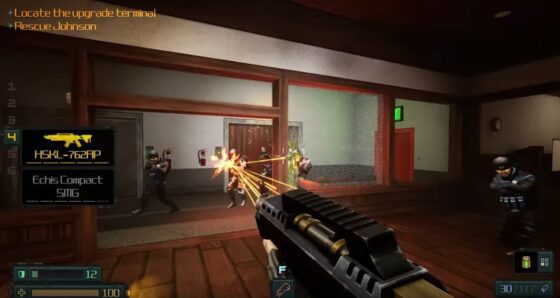
Just like in the previous entry, Phantom Fury has a variety of levels. Shelly will be battling in research facilities, mining towns, and city landscapes. There is also a vehicle selection that lets Shelly get to drive an armored jeep. However, with many moving parts in the background, there can be glitches. Enemies can get clipped into the floor or behind doors. Objects and vehicles can also launch themselves if they collide in merely the wrong part. Depending on your level of immersion, you’ll either enjoy or dislike the number of physics-based puzzles the game throws at you. Shelly will be forced to stack objects to make makeshift ladders to reach exits. It can be a pain at times, especially if you have died and have to repeat large selections. Players will soon know the trouble of not having a quick save when there are too far and few checkpoints in the game. This can be bothersome when restarting in levels with big layouts taking the time to retrace to the last spot.
At its current build, Phantom Fury lacks some polish that other retro shooters have achieved. It does take some wind-up time for the game to pick up the pace, but Half-Life had a similar model too. The game shines when there is a focus on action beats. Battles with lots of enemies converging and there is room to dodge. The game feels rewarding when rolling bombs into groups, sliding into cover, then locking onto targets with Loverboy. Phantom Fury may not reinvent on many fronts, but it’s enjoyable when unleashing a barrage of bullets and mayhem. Phantom Fury was released on April 23rd and is available for PC, Xbox, PlayStation, and Switch.
Gladiator’s Arena (Zach): Another horde survival rogue-lite, Gladiator’s Arena, comes from Afil Games and is out on PC and PS4/PS5. You play as a gladiator in the Colosseum of Ancient Rome. After choosing your starting weapon from seven available options, you battle through deadly animals and fellow gladiators for as long as you can survive. After each round, you get to choose upgrades that can boost your stats or boost specific stats at the expense of others. After beating several rounds, you can earn a skill that will give you some ability, like healing, throwing a spear, or adding elemental effects to your weapons.
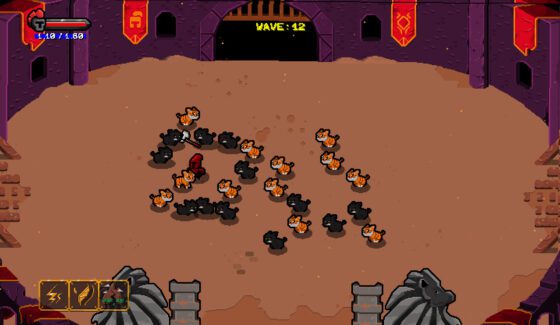
The game has a very cutesy art style that makes the animals attacking you seem more like kittens than deadly beasts, but there are dozens of them at a time, making them feel like a threat. Hopefully, there are a few things that can improve if Afil continues to update and improve the game. The enemy variety is tiny, and you earn an achievement for beating each enemy type within the first few rounds of starting the game. There is also the shield weapon, which is highly overpowered and effectively breaks the game. There are also some abilities that you can equip early on, like life drain, that make the game feel a bit too easy. If you’re getting into Vampire Survivors-style games, this would be a great intro to ease into the genre, but veterans of the genre will probably be bored and unchallenged. The game also only features the same arena stage for every round, and it could use some traps or hazards or a change of venue to shake things up. Gladiator’s Arena is a solid game (and only costs $2.99), but veterans of the horde/rogue-lite genre will probably want to pass it up for more interesting and challenging entries in the genre.
Reveil (Chris): A father awakens in his home to find his wife, Martha, and daughter are missing. As he tries to remember what happened, his memories of a strange circus and dark visions blur his reality. Now Walter Thompson has to rediscover his past to save his family in Reveil. Developed by Pixelsplit and published by Daedalic Entertainment, Reveil is a first-person psychology horror title. The game is filled with unnerving visuals and sounds that will make exploring the surroundings a bit creepy. But you’ll have to be on the lookout for clues and hints in the distorted landscape that will get Walter one step closer to the truth.
Reveil main gameplay centers around exploration and puzzle-solving. Walter’s journey will turn the comforting rooms of Walter’s home turn unfamiliar as the game progresses. Cryptic visuals and odd notes hint at some big secret at a circus, that also turns from wholesome to worrisome over time. The puzzles that Walter encounters start pretty simply, with a few just matching the right pieces to their proper placement or rotating objects into the correct position. There aren’t many headscatters for veteran horror fans, but they do exist a few inconvenience spots. You’ll be revisiting clues for an obvious sign, only to discover the solution through abstract guesswork. By the time the second act picks up speed, the game throws a small stealth selection in the game that breaks up the usual pace. It’s not a deep system or anything that radically changes the gameplay. Walter doesn’t suddenly have new combat moves. Even though Reveil doesn’t fully let me explore more of the stealth mechanics, I enjoy the boost of tension those few tense moments bring.
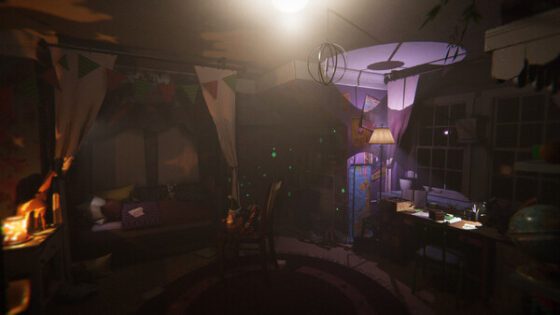
Reveil isn’t packed with enough scare for horror fans, but I believe the game should find an audience with the casual gamer who wants to dabble in the horror genre. The game leans heavily on its atmospheric settings and eerie visuals to keep the player’s attention. However, Walter’s tone doesn’t always reflect the madness occurring. The immersion of a man desperately trying to find his family gets lost when there seems to be no urgency or fear in the delivery. Walter sounds like he is going with the flow and commenting on the oblivious weird stuff. Reveil succeeds in a psychological experience that knows when to end before it drags on. It’s between 3-4 hours of gameplay but could be longer if you aren’t paying attention to puzzle hints. Reveil is a suitable title for a short spooky time that any casual fan can enjoy. Reveil was released on March 6th and is now available for Playstation 4/5, Xbox One/X/S, and PC.
Solforge Fusion (Zach): After playing it at PAX East this year, we checked out Solforge Fusion in Early Access on Steam. From Stone Blade Entertainment and veteran card game designers Justin Gary and Richard Garfield, Solforge Fusion is a collectible card game with thousands of cards and almost limitless deck-building possibilities. The game is a hybrid physical and digital CCG, and any physical packs you buy feature a QR that will allow them to be scanned and used in the digital version. Along with the standard casual and competive PvP gameplay, SolForge Fusion also has a flesh out single player that lets players play as the Forgeborn, who make their way through the world of Solis battling other Forgeborn. The single-player plays as a rogue-like, where you win matches and then choose your path through a branching pathway that leads to random events, extra tough battles and bosses.
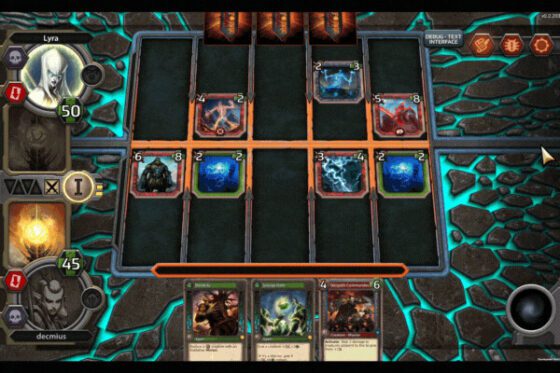
The gameplay feels unique compared to other CCG games like Magic: The Gathering or Hearthstone, as there isn’t any mana or energy to worry about; you can play any card on your turn without worrying about skipping a turn to build up resources. The playfield features lanes, and you and your opponent play various creatures on the lanes. You’re looking to play your creatures in unopposed or weakly defended lanes so you can damage your opposing Forgeborn, and you want to block your opponent so they can’t hurt your Forgeborn. The most prominent unique gameplay element is that a more powerful version goes into your discard pile each time you play a card. After each round of play, you draw a new hand of cards, but after three rounds, you shuffle your discard pile into your draw pile, which lets you potentially get the leveled-up and more powerful creatures into your hand. You can also play a creature on top of a currently deployed creature and send the previous one into the discard pile early. There are also spells that you can use to boost your health or creatures, and the Forgeborn avatar you choose also has a unique ability that you can use once per round. The discarding mechanic makes you think differently from other CCG games as you’re thinking about the current version of that creature and the leveled-up version that is potentially coming up. The digital version plays excellently and has just enough fantastic flourishes and flashy elements to make it feel like more than just a flat and uninteresting digital version of the tabletop game. The single-player campaign is also great and worth checking out the game to play through it outside of the PvP elements. The cards all have fantastic Magic style art, and it’s cool to see what new creatures and spells will come up in a game. Solforge Fusion’s digital version is now in Early Access on Steam, and there’s also a demo you can check out there.
System Shock 1.2 Patch (Chris): System Shock is considered one of the best cyberpunk video games developed, and it was completely remade and released last year. Nightdive Studios has been improving the game to keep the gameplay fresh and challenging. With the 1.2 patch, bigger changes went into to balance the weaponry, enemies, and including a new boss sequence and player options. In System Shock, players assume the role of a nameless hacker who awakens aboard Citadel Station, a sprawling space station overrun by rogue AI SHODAN. Tasked with thwarting SHODAN’s plans, the player navigates through a treacherous environment filled with cybernetic mutants, security drones, and puzzles. The hacker must survive and confront the AI for control of the station.
The gameplay blends first-person shooting, RPG elements, and exploration. Players navigate through the labyrinthine corridors of Citadel Station, confronting obstructions and horrid monsters SHODAN has created. A once-thriving business facility has become a prison for all its inhabitants. The player will carefully explore areas, looking for resources and the next route to SHODAN. The hacker can arm themselves with an array of weapons and gadgets. Each is suited to combat cybernetic enemies and mutated creatures. All weapon types will damage enemies, but using the right weapon type will be more effective on specific enemies. Robotic and cybernetic enemies will be weak against energy-based weapons. Mutated creatures will be weak against explosive-based weapons. But if ammo is low for all the weapons, enemies will fall with enough bashes with a pipe or a wrench.
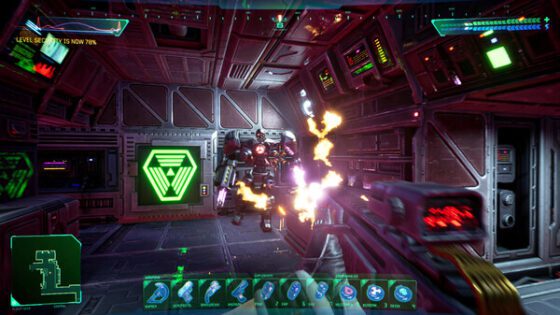
When the player isn’t fighting enemies, they will fetch key cards or solve puzzles to open passageways. System Shock has a non-linear level design and encourages exploration. There isn’t much hand-holding for where to go and how to get there. Only by exploring and getting lost can players find all sorts of shortcuts and item caches. Inventory space is limited, so you’ll have to grab what you can and hopefully return later to loot the rest. There are hacking selections where the hacker has to enter cyberspace. This gameplay shifts to a type of 3D space shooter. The hacker controls a ship-like cyber entity that will explore a virtual space and engage in aerial combat.
The 1.2 patch brings significant updates to the already solid game. Many technical fixes enhanced the graphical performance and the game’s quality of life. This patch gave easy mode gives players mission waypoints, which is handy for new players to get used to the gameplay. The AI has improved and has beefed up the aggression, so camping in one spot for easy kills will be harder. The hacker can be male or female, which changes the hacker’s appearance and the few character sound effects. System Shock is still one of the most atmospheric and challenging game experiences. The remake is a great modernization of the classic and has worked to make the game more accessible to a wider audience. Whether you’re a die-hard fan of the original or a newcomer to the series, the 1.2 patch will make the trip in the hollow halls of the Citadel fun for everyone. System Shock is now available for PC and will be coming to PlayStation 4/5, and Xbox X/S this May 21.
Lunar Lander Beyond (Zach): Atari has been doing a great job recently of bringing back some of their classic IP in new forms, whether the Recharged series of games like Haunted House, which completely reimagines the original game into something modern. Lunar Lander Beyond takes the classic Lunar Lander, a game best known for its exact, momentum-based controls and layers on many modern elements and an actual plot. Developed by Dreams Uncorporated, you are a captain working for the dystopian Pegasus Corporation, who cares more about their profits and equipment than the welfare of any of their employees. Building up a roster of pilots, you need to complete various missions, with bonuses awarded for completing them quickly or with minimal damage to your lander. The missions range from moving through multiple targets in a specific time frame to navigating a tricky stage to pick up a stranded miner or rescue a lost pilot. The game retains the original control style, moving by rotating your ship and then applying thrust. You can quickly get out of control if you go overboard with the thrust, and the key to the game is learning how to use momentum and the best moments to turn on your engines. Unlike the original game, there are tons of abilities you can earn and use to help you navigate the levels, with the biggest lifesaver probably being “Stabilize” which stops your ship’s momentum and resets you back to a neutral position, which is excellent for setting up for landings or to prevent from careening into an obstacle. It takes a bit to get used to, but it feels great when you get the hang of it and get the perfect thrust and arc through sections of the level.
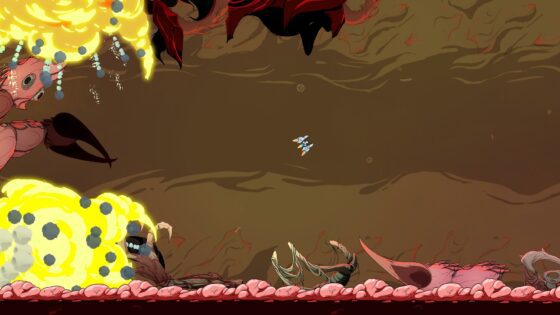
The game’s story is fun, with some funny dark humor and an eclectic cast of characters. The in-between mission cutscenes and the game’s overall look have an animated Saturday morning cartoon style that looks great, especially when you are in the missions. As you progress through the story, you unlock new pilots, new abilities, and new ships, with the latter having different stats that can make the game more challenging, like a fast ship that could blow up just by brushing an obstacle. There’s also the element of stress that your pilots can accrue. Suppose a pilot gets too stressed from crashing or failing missions. In that case, they can start experiencing adverse effects that can lead to full-on madness, where they begin seeing hallucinations like giant eyeballs and pink elephants on screen. You can use various methods to lower pilot stress between missions or switch to a less stressed pilot for your next stage. If you’re playing on the highest difficulty, you also have to worry about permadeath, where if your lander is destroyed in a stage, that pilot is dead forever. Lose all your pilots, and it’s game over. Lunar Lander Beyond is an excellent hybrid of old and new, keeping the classic controls of the original game but adding a ton of new elements and modern gameplay elements that should appeal to old-school and new fans. Lunar Lander Beyond is out now on PC and Nintendo Switch, PlayStation 4|5, Atari VCS, and Xbox Series X|S.



